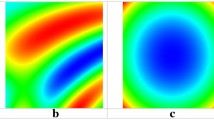Abstract
Wireless sensor networks (WSNs) have become a hot area of research in recent years due to the realization of their ability in myriad applications including military surveillance, facility monitoring, target detection, and health care applications. However, many WSN design problems involve tradeoffs between multiple conflicting optimization objectives such as coverage preservation and energy conservation. Many of the existing sensor network design approaches, however, generally focus on a single optimization objective. For example, while both energy conservation in a cluster-based WSNs and coverage-maintenance protocols have been extensively studied in the past, these have not been integrated in a multi-objective optimization manner. This paper employs a recently developed multi-objective optimization algorithm, the so-called multi-objective evolutionary algorithm based on decomposition (MOEA/D) to solve simultaneously the coverage preservation and energy conservation design problems in cluster-based WSNs. The performance of the proposed approach, in terms of coverage and network lifetime is compared with a state-of-the-art evolutionary approach called NSGA II. Under the same environments, simulation results on different network topologies reveal that MOEA/D provides a feasible approach for extending the network lifetime while preserving more coverage area.
Similar content being viewed by others

References
Halawani S., Khan A. W. (2010) Sensors lifetime enhancement techniques in wireless sensor networks—a survey. Journal of Computing 2(5): 34–47
Heinzelman W., Chandrakasan A., Balakrishnan H. (2002) An application-specific protocol architecture for wireless microsensor networks. IEEE Transactions on Wireless Communications 1(4): 660–670
Tian, D., & Georganas, N. D. (2002). A coverage-preserving node scheduling scheme for large wireless sensor networks. In Processing of ACM wireless sensor network and application workshop.
Ye, F., Zhong, G., Cheng, J., Lu, S., & Zhang, L. (2003). PEAS: A robust energy conserving protocol for long-lived sensor networks. In Proceedings of IEEE international conference on distributed computing systems (ICDCS 2003).
Zhang, H., & Hou, J. (2004). Maintaining coverage and connectivity in large sensor networks. In Proceedings of international workshop on theoretical and algorithmic aspects of sensor, Ad hoc wireless and peer-to-peer networks.
Cardei M., Du D. Z. (2005) Improving wireless sensor network lifetime through power aware organization. ACM Wireless Networks 11(3): 333–340
Jourdan D. B., de Weck O. L. (2004) Layout optimization for a wireless sensor network using a multiobjective genetic algorithm. IEEE Semiannual Vehicular Technology 5: 2466–2470
Deb K. (2002) Multi-objective optimization using evolutionary algorithms. Wiley, New york
Coello C. A. C., Lamont G. B., Van Veldhuizen D. A. (2007) Evolutionary algorithms for solving multi-objective problems (2nd ed.). Springer, Berlin
Kulkarni R. V., Förster A., Venayagamoorthy G. K. (2001) Computational intelligence in wireless sensor networks: A survey. IEEE Communication Surveys & Tutorials 13(1): 68–96
Rajagopalan, R., Mohan, C., Varshney, K. P., & Mehrotra, K. (2005). Multi-objective mobile agent routing in wireless sensor networks. In Proceedings IEEE congress on evolutionary computation (Vol. 2, pp. 1730–1737). Edinburgh, Scotland.
Martins, F. V. C., Nakamura, F. G., Quintao, F. P., & Mateus, G. R. (2007). Model and algorithms for the density, coverage and connectivity control problem in flat WSNs. In Proceedings of the international network optimization conference (I NOC’07), pp. 1145–1152.
Martins F. V. C., Carrano E. G., Wanner E. F., Takahashi R. H. C., Mateus G. R. (2011) A hybrid multiobjective evolutionary approach for improving the performance of wireless sensor networks. IEEE Sensors Journal 11(3): 545–554
Srinivas N., Deb K. (1994) Multi-objective function optimization using non-dominated sorting genetic algorithms. Evolutionary Computation 2(3): 221–248
Deb, K., Pratap, A., Agarwal, S., & Meyarivan, T. (2000). A fast and elitist multi-objective genetic algorithm: NSGA-II. In Proceedings Parallel Problem Solving from Nature VI, pp. 849–858.
Zhang Q., Li H. (2007) MOEA/D: A multi-objective evolutionary algorithm based on decomposition. IEEE Transactions on Evolutionary Computation 11(6): 712–731
Smaragdakis, G., Matta, I., & Bestavros, A. (2004). SEP: A stable election protocol for clustered heterogeneous wireless sensor networks. In Second international workshop on sensor and actor network protocols and applications (SANPA 2004), Boston, MA.
Khalil, E. A., & Attea, B. A. (2011). Energy-aware evolutionary routing protocol for dynamic clustering of wireless sensor networks. Swarm an Evolutionary Computation. doi:10.1016/j.swevo.2011.06.004.
Author information
Authors and Affiliations
Corresponding author
Rights and permissions
About this article
Cite this article
Özdemir, S., Attea, B.A. & Khalil, Ö.A. Multi-Objective Evolutionary Algorithm Based on Decomposition for Energy Efficient Coverage in Wireless Sensor Networks. Wireless Pers Commun 71, 195–215 (2013). https://doi.org/10.1007/s11277-012-0811-3
Published:
Issue Date:
DOI: https://doi.org/10.1007/s11277-012-0811-3



